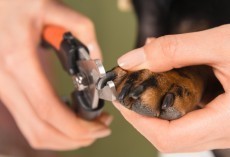Whether it be cancer, heart or a liver problem it’s obvious that a dogs' senses can detect things early and we should pay attention to their moods when it comes to a potential medical problem!
Cancer
Perhaps the condition dogs are currently most famous for detecting is cancer. Dogs have been able to sniff out a variety of types including skin cancer, breast cancer and bladder cancer.There are quite a few stories of a pet dog obsessing about an owner's mole or some part of their body, only to discover in a doctor's appointment that the dog was actually sensing cancer. For example, Canada Free Press writes of a 1989 instance when a woman's “dog kept sniffing at a mole on her thigh, but ignored other moles. In fact, the dog had actually tried to bite off the mole when she was wearing shorts. The woman consulted her doctor, the mole was excised and the diagnosis confirmed a malignant melanoma.”
In studies, dogs have successfully been trained to detect the disease using samples from known cancer patients and people without cancer.
Narcolepsy
Narcolepsy is a brain disorder that affects the ability to control sleep-wake cycles. This can mean a person suddenly falls asleep, even in the middle of a task. It's a dangerous condition, as someone who has an attack could be injured falling to the ground or could have a car accident if it happens while driving.Mary McNeight, Service Dog Academy director of training and behavior, has been working with narcolepsy service dogs since 2010, and she notes that there's a scent the dogs pick up on when an attack is coming on. “It’s a biochemical change in the body. We do not know what the particular odor smells like due to the difference between human scent perception and dog scent perception,” she tells Sleep Review.
In a study published in 2013, Luis Dominguez-Ortega, M.D., Ph.D., found that two trained dogs detected 11 of 12 narcolepsy patients using sweat samples, demonstrating that dogs can detect a distinct scent for the disorder.
Service dogs help people with narcolepsy by performing several different types of tasks. They can stand over the person's lap when an attack comes on, which prevents them from sliding out of a chair onto the floor; they can also stand over the person to protect them if they are out in public, or they can go get help. And most importantly, they can provide a warning up to 5 minutes before an attack comes on, giving their handler a chance to get to a safe place or a safe position.
Dogs can smell all sorts of chemical changes in our bodies, including a drop in blood sugar or even the onset of a migraine.
Migraines
For those who suffer migraines, having a warning before one comes on can mean the difference between managing the problem or succumbing to hours or days of intense pain. Fortunately, some dogs have a talent for sniffing out the signs that a migraine is on the way.Psychology Today reports on a recent study that asked migraine sufferers with dogs if they noticed a change in their dogs' behavior before or during a migraine. The results show that “54 percent of the 1027 participants indicated they had noticed changes in the behavior of their pets during or preceding migraines. Nearly 60 percent of these subjects indicated that their dog had alerted them to the onset of a headache — usually an hour or two in advance.” The results are fascinating, though it's important to point out that the study was conducted with self-reports rather than observation by researchers. Even so, the study shows evidence that many dogs seem to detect and point out a change in their human companion's health.
Seizure
One of the more controversial areas where dogs are used to alert to a medical condition is with seizures. There is growing evidence that dogs can and do detect the onset of a seizure; however, the level of accuracy and, most importantly, our ability to train dogs to alert a handler to an oncoming seizure remains a bit questionable.As is the case with some other conditions, dogs cannot be trained to predict seizures. We don't have a way to provide them with a scent or information that can be used for training. We can, however, train dogs how to respond to and assist a handler when a seizure occurs. Some service dogs that are placed with seizure patients do develop the ability to detect when a seizure is coming and can provide an alert if the handler pays close attention to the signals the dog provides.
Fear and Stress
The age-old notion that dogs can smell fear is an accurate one. Dogs can smell when we are feeling fear or are experiencing an increased level of stress, even if we aren't showing outward signs. What dogs are smelling is the surge of hormones our bodies release to respond to stressful situations, including adrenalin and cortisol.Thankfully, this can be used to humans' benefit, as dogs can signal a handler that they (or someone else) needs to take a few deep breaths. Dogs that alert handlers of the change in their emotional state — a change that often people aren't even aware they're experiencing — can help prevent panic attacks and other possible episodes associated with post-traumatic stress disorder or other issues.
The more we learn about our dogs and the incredible things they can do with a simple sniff from their noses, the more we have to realize that Fido being called “man’s best friend” is not just an endearment. Without knowing it, our pooches are potential life savers and we love them all the more for it!
For more information go to Mother Nature Network.










Bonnie Linnemeyer-Brown
- Edit
After seeing a doctor and having a physical and being deemed well, my dogs discovered that I had breast cancer.
Robert M.P Ocasio
- Edit
OMG
Jane Carrillo
- Edit
interesting
Regina Pokropski
- Edit
Amazing